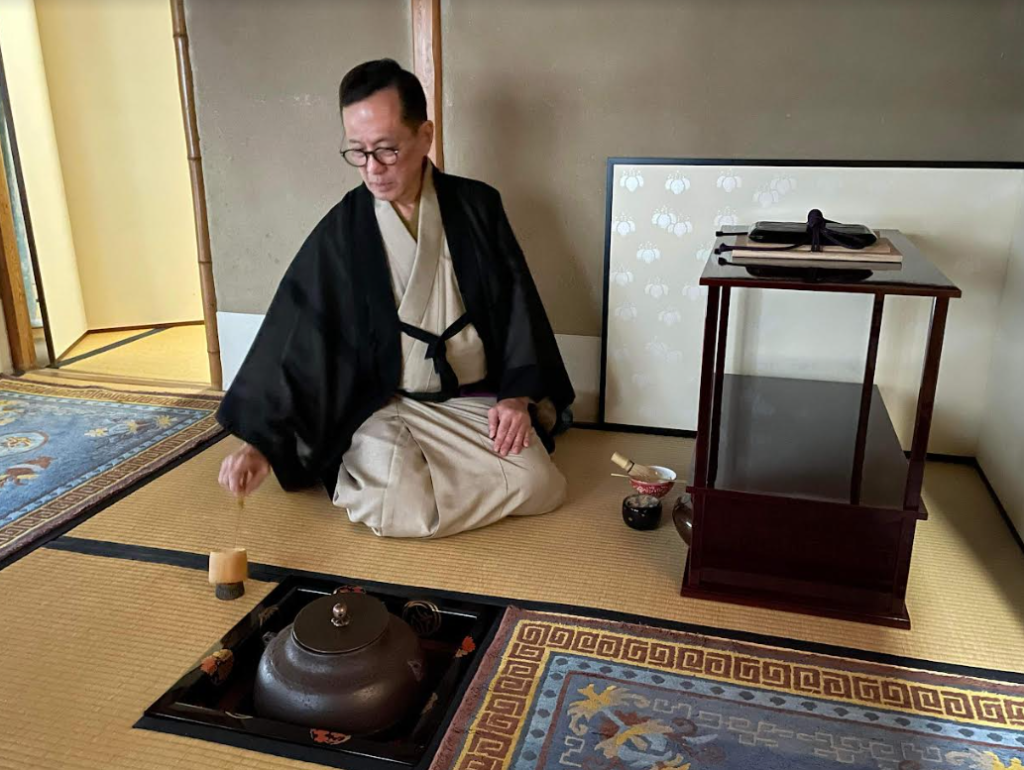WiK Members Enjoyed a New Year’s Bowl of Tea – Jan. 7, 2024
Photos by Karen Lee Tawarayama and Kirsty Kawano
Four guests from WiK were guided by fellow member Bruce Hamana (Hamana Sosei sensei), a tea master born in Hawaii, and teacher of the Urasenke tea school, to a New Year’s celebratory tea gathering at Tenki, a large and sumptuous tempura restaurant near Senbon Imadegawa, Kyoto, which has a garden and tea house complex. Bruce had been supervising and making tea all day there with his students, one of whom, Minami Okawa, joined us in the tea room as Bruce’s assistant.
Bruce has worked at Urasenke in various capacities for years, and has served as an ambassador around the world, demonstrating and explaining tea. He now has various groups of students and also “teaches the teachers” how to explain about tea in English. He is the author of 100 Beautiful Words in the Way of Tea (Tankosha 2020), an English guide to poetic seasonal names and expressions used in the tearoom, with plenty of information about them. He is presently working on a book about the 72 Japanese micro-seasons.
We were led through the garden, replete with winter beauty, briefly into another room, to view a traditional New Year decoration which replaced the more usual kagami-mochi with large pieces of charcoal, and had many other symbolic features including the daidai citrus fruit, whose name can also mean “from generation to generation” and signifies the continuation of life and tradition, bridging the New Year period to the next year. A preliminary treat was the serving of hanabira-mochi, a special New Year sweet made with burdock root and miso, many tastes at once, which is particular to Urasenke.

Purifying ourselves at the tsukubai, a small stone basin, in the garden, we entered the tearoom in the traditional manner through the nijiriguchi, a small square door which must be crawled through, meaning that social differences drop away, and inside the tea room everyone is equal. Bruce had thoughtfully provided small stools for us to sit on, so we did not have to endure the discomfort of the more traditional floor posture known as seiza. This was very considerate, but gave me a stab of regret that due to uncooperative knees, I was no longer able to participate in a tea gathering in the usual way, including receiving the bowl of tea and viewing the utensils afterward, which were difficult from stool level. Bruce and his students were very friendly and caring, allowing us, even though we were not sitting on the floor as is customary, to participate with a few little changes and enjoy ourselves to the full.
The room was small and intimate, and very dim, which made a pleasant change from the brightly-lit environments of everyday. Bruce made the tea with very little fuss, speaking about various things, including instructing us on what to do, not so much the order of the ceremony, which was obviously for him secondary to putting the guests at ease and answering questions. It was a treat for me to watch such an unobtrusive tea ceremony without the usual “Sensei, what do I do now?” which is prevalent in tea classes. Bruce’s mastery allowed us to feel peaceful, and chased away any feeling of being nervous because of unfamiliarity with the procedure. He led us with a gentle and sure hand through the intricacies of being guests at a tea gathering.

The tokonoma was decorated with a camellia bud and shuttlecock-shaped plant in a Chinese formal metal vase, and sweeping branches of willow, one of which was tied in a loose knot. The scroll had the four characters of wakei seijaku (harmony, respect, purity, and tranquility) – characteristics not only of tea, but of traditional Japanese culture as a whole. The tea was made in front of a formal old-style cabinet, which had a decoration of writing materials on top. We guests were charmed with the serving of dry sweets in small folded boxes, celebratory red and gold in color, and with the variety of interesting bowls in which we received the tea, a few mouthfuls of hot, bubbly moss-green matcha.
After drinking the tea (with some second serves!), the conversation turned to Bunraku, the puppet theatre, where Minami-san works, and she told us of a possible tour of the backstage which may be offered to WiK members later in the year. Watch this space!
Special thanks to Hamana sensei for allowing us to share in this special day, and also to Kirsty Kawano, who helped organize WiK’s participation. It was a telling reminder that there are many ways to experience Kyoto’s beauty, and that Writers in Kyoto is home to many talented people who, not only by writing but in other ways, widen the horizons of all who seek to share this beauty.
